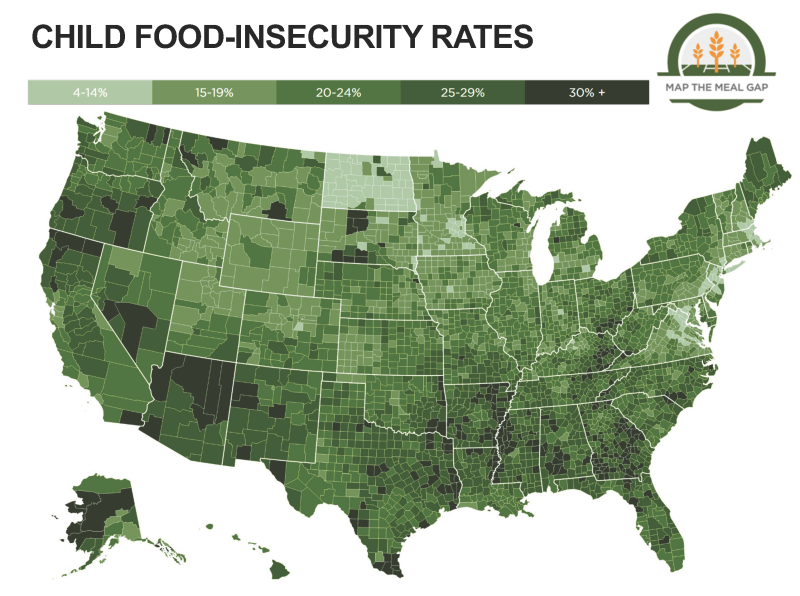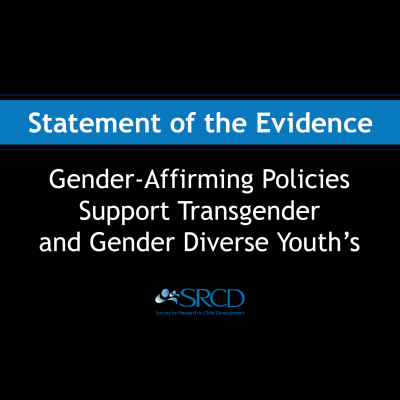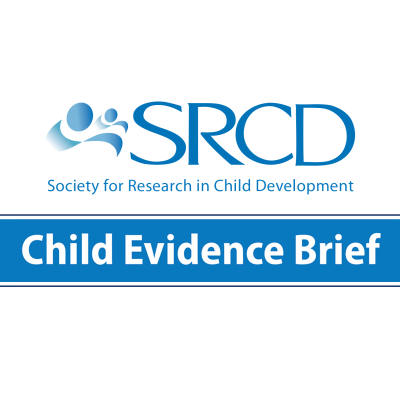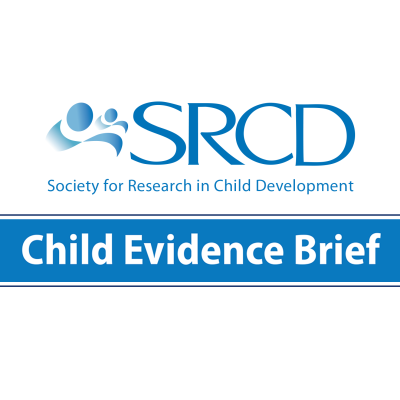Targeted Policies Can Reduce the Harmful Consequences of Food Insecurity for Children
Edited by Rebekah Levine Coley, Ph.D., Boston College. For more information, contact Kelly R. Fisher, Ph.D., Director for Policy, Society for Research in Child Development, at policy@srcd.org.
Authors
- Barbara H. Fiese, Ph.D., University of Illinois at Urbana Champaign
- Craig Gundersen, Ph.D., University of Illinois at Urbana Champaign
Food insecurity, or not having access to enough food to live an active, healthy lifestyle, affects one out of six households with children and nearly one out of three households headed by single mothers in the United States. Food insecurity affects two generations: Its consequences include poor physical and mental health and reduced academic performance in children, as well as compromised mental health and parenting skills in adults. Food insecurity is also linked to increased health care costs. Research shows that federal food assistance programs have positive effects on the health and well-being of children, but the benefits of federal programs could be further strengthened.
One in Six Children Experience Food Insecurity
Concerns about child food insecurity are due, in part, to its magnitude. For example, in 2016:1
- 16.5% of all households with children under 18 were food insecure,
- 31.6% of households with children headed by a single mother were food insecure, as were 9.9% of married couple households, and
- 38.3% of poor households were food insecure.
Food insecurity among children is concentrated in specific geographical regions. For example, a quarter of children in Arkansas, Mississippi, and New Mexico experience food insecurity (see Figure 1). Yet food insecurity also occurs across the U.S. population, with all states except North Dakota experiencing a child food insecurity rate of over 12%. Although families with children have particularly high rates, food insecurity is also experienced in 10.5% of households without children, as well as in 5.6% of middle-income households (households with income greater than 185% of the poverty line).1
Figure 1. Child Food Insecurity Rates by County, 2015

Source: Feeding America's Map the Meal Gap.
Food Insecurity Affects Both Children and Parents
Research shows that infants and toddlers raised in food insecure households are more likely to:2
- experience iron deficiency and iron deficiency anemia,
- have poor health, and
- be hospitalized.
School-age children raised in food-insecure households are: 3,4,5
- less likely to have the social and emotional skills necessary to succeed in school,
- more likely to be suspended from school, and
- at greater risk for internalizing and externalizing behavior problems (e.g., anxiety, depression, aggression).
Food insecurity can also disrupt the parenting process. Parents raising children in food-insecure households are more likely to experience depression and anxiety, and to engage in harsh discipline. 6,7 Together, the effects of food insecurity on children’s and adults’ health impede productivity and raise health-care costs. 8,9
Food Assistance Programs Help Alleviate Children’s Food Insecurity
The two largest food assistance programs in the United States are the Supplemental Nutrition Assistance Program (SNAP), which provides monthly benefits to more than 44 million children and adults, and the free and reduced price National School Lunch Program (NSLP), which feeds more than 30 million children a day during the school year. The Special Supplemental Nutrition Program for Women, Infants, and Children (WIC) supports an additional 7.3 million women and young children each month.10 Evidence shows that SNAP is extraordinarily successful at alleviating food insecurity among children.10 For example, one study estimated that for households with children, participation in SNAP reduced food insecurity by 63%.11 The WIC program has also reduced food insecurity in eligible households by at least 20%12 and the NSLP reduces the prevalence of poor health in children by at least 29%.13
What Could be Done to Further Reduce Food Insecurity in Children?
Evidence suggests three main ways that food assistance programs could succeed even more at alleviating food insecurity among children:
- First, increasing the level of SNAP benefits would expand the efficacy of the program.14,15,16 Current benefit levels reduce but are not sufficient to eradicate food insecurity. Recent evidence suggests that raising SNAP benefits by 29% could eliminate food insecurity in recipient households with children.15
- Second, raising the income eligibility threshold would alleviate food insecurity among many more children. Research suggests that raising the gross income eligibility threshold for SNAP from 130% to 185% of the poverty line, bringing it in line with other programs for children (e.g., NSLP, WIC), would reduce food insecurity rates 60.3% among currently ineligible households with children. 15
- Third, expanding the Summer Food Service Program (SFSP) could decrease food insecurity among multiple members of the household. Children’s food insecurity rises in summer due to lack of school meals. Expanding the SFSP would both reduce food insecurity for children and free up resources for other members of the household. 17
Food insecurity harms children’s development and family functioning and raises health care expenditures. The costs of increasing food assistance programs need to be weighed against the benefits of improved well-being for children and their future participation in the economy.
Endnotes / References
(1) Coleman-Jensen, A., Rabbitt, M. P., Gregory, C. A., & Singh, A. (2017). Household food security in the United States in 2016. Economic Research Report. Economic Research Service, USDA. Issue 237.
(2) Cook, J. T., & Frank, D. A. (2008). Food security, poverty, and human development in the United States. Annals of the New York Academy of Sciences, 1136, 193-209.
(3) Johnson, A. D., & Markowitz, A. J. (2018). Associations between household food insecurity in early childhood and children’s kindergarten skills. Child Development, 89, e1-e7.
(4) Alaimo, K., Olson, C.M., & Frongillo, E. A. (2001). Food insufficiency and American school-aged children’s cognitive, academic, and psychosocial development. Pediatrics, 108, 44-53
(5) Slack, K. S., & Yoo, J. (2005). Food hardship and child behavior problems among low-income children. Social Service Review, 79, 511-536.
(6) Whitaker, R. C., Phillips, S. M., & Orzol, S. M. (2006). Food insecurity and risks of depression and anxiety in mothers and behavior problems in their preschool-aged children. Pediatrics, 118, e859-868.
(7) Gill, M.K., Koleilat, M., & Whaley, S. E. (2018). The impact of food insecurity on the home emotional environment among low-income mothers of young children. Maternal and Child Health Journal. https://doi.org/10.1007/s10995-018-2499-9.
(8) Tarasuk, V., Cheng, C., Oliveira, N., Dachner, C., Gundersen, C., & Kurdyak, P. (2015). Association between household food insecurity and annual health care costs. Canadian Medical Association Journal, 187, E429-E436.
(9) Berkowitz, S., Basu, S. Meigs, J., & Seligman, H. (2017). Food insecurity and health care expenditures in the United States, 2011-2013. Health Services Research, Doi:10.1111/1475-6773.12730.
(10) Oliveira, V. (March, 2018). The Food Assistance Landscape: FY 2017 Annual Report, EIB-190, U.S. Department of Agriculture, Economic Research Service.
(11) Gundersen, C., Kreider, B., & Pepper, J. (2017). Partial identification methods for evaluating food assistance programs: A case study of the causal impact of SNAP on food insecurity. American Journal of Agricultural Economics, 99, 875-894.
(12) Kreider, B., Pepper, J., & Roy, M. (2016). Identifying the effects of WIC on food insecurity among infants and children. Southern Economic Journal, 82 (4), 1106-1122.
(13) Gundersen, C., Kreider, B., & Pepper, J. (2012). The impact of the National School Lunch Program on child health: A nonparametric bounds analysis. Journal of Econometrics, 166, 79-91.
(14) Ziliak, J. (2016). Modernizing SNAP benefits. Policy proposal 2016-06. The Hamilton Project. Washington DC: Brookings Institution.
(15) Gundersen, C., Kreider, B., & Pepper, J. (2018). Reconstructing SNAP to more effectively alleviate food insecurity in the U.S., RSF: The Russell Sage Foundation Journal of Social Sciences, 4, 113-130.
(16) Waxman, E., Gundersen, C., & Thompson, M. (2018). How far do SNAP benefits fall short of covering the cost of a meal? Urban Institute, From Safety Net to Solid Ground.
(17) Nord, M., & Romig, K. (2006). Hunger in the summer. Seasonal food insecurity and the National School Lunch and Summer Food Service programs. Journal of Children & Poverty, 12, 141- 158.


